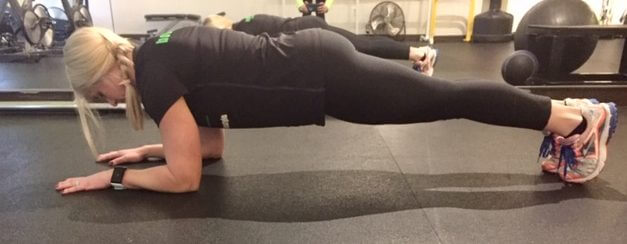How to Plank and
The Top 3 Reasons Why You Should
The infamous plank. It’s a staple core exercises – and for good reason. Whether you love them or hate them (most people lean toward the latter), there’s not much to debate when it comes to its benefits. So what’s so great about them, anyway?
1) Planks Increase Core Stability and Endurance
Planks are an isometric exercise, meaning the muscles are not shortening or lengthening but instead, staying the same length. By training your core in this way, you are teaching your abdominals to support your trunk. That may not sound like a big deal to you, but keep in mind your core must have enough strength and endurance to hold you in an upright position all day. As you train with planks, you will notice your posture will improve and your back pain may even get better with time since it’s not forced to compensate for lazy abdominal muscles. Speaking of back pain, planks are a great option if you are suffering from pain or discomfort since you aren’t flexing the spine or twisting in a way that may irritate the injury. As always, consult with a doctor of physical therapist before incorporating planks into your routine if you are dealing with pain.
2) Planks Lay the Foundation for Other Exercises
As mentioned above, planks are a great posture exercise and they train your abdominals to engage properly during other exercises. If you can imagine holding your core tightly like you would in the plank during almost any other exercise, you will reap the benefits of working your core without doing a “strict core exercise”. Next time you are squatting or deadlifting, think about tightening your core like you would in the plank. You’ll notice your back will feel more supported and in return, you will be lifting more safely all by this small change.
3) Planks Don’t Require Equipment
What’s the best part about planks?? All they require is YOU! You can literally do them anywhere. Now that you’re sold on incorporating planks into your fitness routine, here’s how it’s done!
Plank Basics
High Plank: Start on all fours and lift up into a push-up position. Focus on pulling your navel toward your spine and don’t forget to breathe! This is called a “high plank”. This is a great option if you have back pain, since it’s a little less intense than a low plank or elbow plank. Try to focus on keeping your body in a straight line from your shoulders to your toes. Check your position in the mirror until this posture is second naturefor you. Start with holding this position for a few seconds then work up to 1 minute or more. If this is too difficult for you, try an incline plank by elevating your hands on a bench or a couch to add more support.

Low Plank (ElbowPlank): Same as the high plank except you will be on your elbows instead of your hands. This is slightly more difficult than the high plank.

Advanced Versions
Bear Plank: Startingin your high plank position, walk your feet in slightly and bend your knees sothey are directly beneath your hips. Your knees should be hovering a few inches above the ground. You should form a tabletop with your body.

Side Plank: Place your elbows directly under your shoulder and stack or stagger your feet. Lift your hips as high as you can to make a straight line. If this is too difficult, bend your bottom leg for extra support. Don’t forget to do both sides!

Medicine Ball Plank: The medicine ball adds an extra stability challenge since you will have to work to keep it from rolling. Same steps as the high plank except you will butterfly your hands on the ball. The smaller the ball, the bigger the challenge!

Exercise Ball Plank: Place an exercise ball under your elbows and follow the steps for a low plank. For an added challenge, try rolling the ball in different directions while holding the plank position.

Long Lever Plank: Don’t be fooled, this one looks easy but it’s tough! Start in a high plank, then walk your hands out in front of your body. Remember to stay in a straight line. This is also a great upper body challenge!

